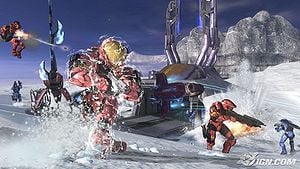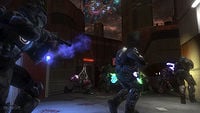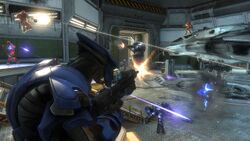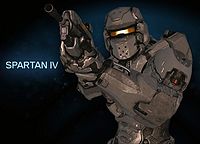Multiplayer
From Halopedia, the Halo wiki
- "Two men enter. The better man leaves. The lesser man is respawning. And that's Halo."
- — Luke Smith
The term "Multiplayer" generally refers to the ability of most video games allowing more than one person to play a game at the same time in a non-campaign setting. Multiplayer can be conducted using split-screen, System Link, or online. In the Halo games, multiplayer has been regarded as a core element to the game's design and a giant part of the success of the Halo franchise.
Background
Multiplayer matches in Halo tend to focus on the completion of an objective, with the objective in question being determined by the gametype being used. Players use weapons, equipment, and vehicles to advance toward the objective while inhibiting their opponents' progress. These items are commonly used, as one might expect, to score kills. Scoring kills can be helpful even in non-deathmatch games, as a killed opponent will often respawn away from their objective and without their preferred weapons.
In more recent games in the series (from Halo 3 onwards), modes of play are accessed through lobbies. While in lobbies, players can organize themselves into groups called 'parties'.[note 1] Each party has one party leader, who controls the lobby that the party will play in and the settings that they will use. Party leaders can leave the party open (allowing other players to join at any time) or restrict it to an invite-only status (other players must be invited by members of the party in order to join). They can also promote a another player in the party to party leader.
Though some Halo games with support for online multiplayer have used (user-established) dedicated servers, most games in the franchise rely on a distributed networking model. In such a model, the players' consoles connect to each other directly, with one console acting as a server.
As is the case with virtually every competitive activity in human society, people have tried to cheat while playing Halo. Numerous arguably-unfair practices, such as camping, team-killing, and the Noob Combo, are used for the same reason. A multiplayer map can take as many as sixteen players.
Profiles
Each Halo first-person shooter allows players to create profiles, which are used to store information about players. Halo profiles store both a player's game settings and some customized visual details to distinguish the player. In Halo games made for Xbox Live, profiles are bound to gamertags; all gameplay is conducted with a profile, and players without gamertags are granted temporary profiles for the duration of their session.
The profile creator in Halo: Combat Evolved was very basic. Players had the ability to create a unique name, customize their armor color, and change the game controls and settings. Halo PC's settings were more intricate, including various sound and video settings as well as the ability to create custom control schemes (as opposed to picking preset control schemes).
With the addition of online multiplayer through Xbox LIVE, the profile creator in Halo 2 was redesigned and altered. Halo 2 introduced additional armor colors and the ability for a player to use two colors for their armor. Major additions included the ability to play as a Sangheili in multiplayer and the additions were notable for allowing players to identify teammates at a glance—a sharp contrast to the unmarked waypoints shown in Halo: Combat Evolved.
The updated profile creator in Halo 3 kept those settings and added more. Players could create a Service Tag consisting of a letter and two numbers; Service Tags are now shown over waypoints instead of Emblems. Additional Emblem designs, colors, and features were added. Bungie also added a gender option, which changes the player's voice. The most notable addition, however, was the Armor Permutations, which allows players to change the models used for their helmets, pauldrons, and chestplates.
Halo: Combat Evolved
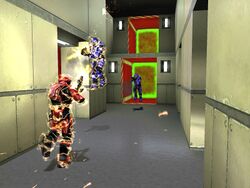
The multiplayer component of Halo: Combat Evolved's Xbox version was limited to split-screen and System Link play. Five core gametypes existed: Slayer, Oddball, Capture The Flag, King of the Hill, and Race. Various stock variants with altered settings existed, and players could create their own.
Though the game did not support online multiplayer, network tunneling programs, such as XBConnect and XLink Kai, could be used to coerce the game into running online. However, the game tends to freeze and stutter while it works to keep things synchronized—today's internet connection speeds come nowhere close to the 100 megabit connection that the game expects.
Halo PC
The PC version supports online multiplayer, and can run games with custom gametypes and up to sixteen players. Six additional maps were also added to the game: Danger Canyon, Death Island, Gephyrophobia, Ice Fields, Infinity, and Timberland. Two additional weapons—the Flamethrower and the Fuel Rod Gun—became usable in the PC version as well.
Players can host both listen servers and dedicated servers. A server browser, provided by GameSpy, comes with the game, though players can also use a LAN browser to find servers. (Alternatively, the IP address or domain name of a server can be accessed directly.) Unfortunately, the game lacks any kind of stat tracking, standardized rules, banlists, or cheat detection past what server administrators provide; this complicates competitive organization and the prevention of cheating and griefing.
Halo Custom Edition
Halo Custom Edition, a multiplayer-only expansion of Halo PC, allowed players to run user-created maps and gametypes online. Such maps could be created using the Halo Editing Kit. Amongst these maps were a number of Halo 2-based maps, such as Zanzibar[1] and Coagulation.[2] In addition, there are a vast number of non-canon maps set in Halo-inspired locations using only Halo assets, as well as many other maps which incorporate custom weapons, vehicles, locations, and player models.
Halo 2
- "They say all good things must come to an end. Well, we say that totally sucks! Thanks for treating our old gal right for all these years. And thanks a million for playing. <3,"
- — Bungie's farewell message
Halo 2's multiplayer functionality was completely redesigned to work with Xbox Live. Matchmaking allowed players to search for games in a variety of different playlists, such as Team Objective, Team Doubles, and Rumble Pit; players could find each other quickly, relatively anonymously, and without having to sort through their friends list. Players could also create and host their own Custom Games, and could invite other players to join them. The lobby system was also introduced; each form of multiplayer was given a lobby, so that players in a party could stick together after a match.
Putting Microsoft's Trueskill system to use, Bungie employed a ranking system that displayed a level (1-50) based on how well a player played in a particular playlist. Rankings were for individual playlists, and players who would continually win games in a certain playlist would rank up in that playlist. Bungie also split their multiplayer component into two major categories; ranked and un-ranked. While the ranked playlists offered players a chance to display skill, the un-ranked playlists were more social and relaxed, and allowed guests.
Halo 2 introduced the concept of awarding medals to players for various accomplishments during a match, such as multikills and sprees, as well as kills caused by certain weapons or vehicles. Medals are shown on Bungie.net's game viewers and in the Postgame Carnage Report. The Race gametype was removed due to a lack of popularity, and three new gametypes were introduced: Juggernaut, Assault, and Territories.
Since Microsoft discontinued Xbox LIVE support for the original Xbox on April 15, 2010, Halo 2 is no longer playable online.
Halo 2 Vista
Halo 2 Vista utilized the Games for Windows LIVE service, but in a much different way from its Xbox counterpart. Rank-based Matchmaking was done away with, and, like its predecessor, Halo PC, Halo 2 Vista added a server browser and allowed players to join games in progress. Servers ran a map cycle in the form of a playlist, where players would congregate in a lobby until the game starts, play the game, then go back to the lobby to review the Postgame Carnage Report and chat with other players until the next round started. LIVE Gold users could filter out servers not matching their interests, and quickly jump right into a game in progress by selecting a "Quick Match" option.
Halo 2 Vista did not feature Tombstone or Desolation. It instead offered District and Uplift, as well as the Halo 2 Map Editor, which allowed players to create custom Halo 2 Vista maps.
On July 27, 2008, the Gold-only limitations were removed, and all LIVE subscribers, regardless of membership level, could use all aspects of Halo 2 Vista multiplayer without restriction.[3]
Halo 3
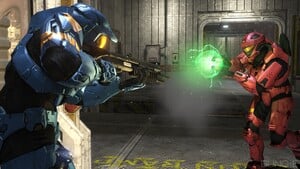
Halo 3 introduced many new features to its multiplayer experience. The most prominent feature was the ability to play the campaign cooperatively online and via system link with up to three other players. Unlike Halo 2 's local Co-op, where players control 'clones' of the same character, each player in Halo 3 is assigned control over Master Chief, the Arbiter, or Elites N'tho 'Sraom and Usze 'Taham.
Custom gametypes were given a whole new level of customization. Numerous settings, including a player's weight, were added. Spawn-time specific attributes could also be assigned; these attributes would last for a set number of seconds after a player spawns. This can be helpful for preventing spawnkilling. Two new core gametypes, VIP and Infection, were added.
Matchmaking was enhanced with many under-the-hood features to help get better player matches and reduce wait time. Two very useful features were added to the pre-game and post-game lobbies: in the former, players can vote to veto gametype-map combinations that nobody wanted to play; in the latter, players could "Party Up", so that players could continue playing together. The number of Medals increased drastically, including Medals for killing sprees with certain weapons, the Linktacular Medal for getting matched with nothing but Bungie.net members, and the Steaktacular Medal for winning a Slayer game by more than twenty points.
Finally, custom games were enhanced with the addition of Forge, a multiplayer map editor. Forge allowed players to manipulate various objects in maps. Altered object configurations could be saved as map variants and uploaded to a player's File Share. Glitches have been used to create particularly interesting map variants.
Ranking, EXP, and Skill
The ranking system introduced in Halo 2 was redone in order to balance out Matchmaking even further. The Trueskill system was still present on ranked playlists, but a new 'Experience (EXP)' stat was added to player profiles. Whenever a player plays a match without quitting and is in the top position or on the winning team, the player gains 1 EXP. Players who enter a playlist, but disconnect or quit early lose 1 EXP for desertion. Players who end up in a losing position or team do not gain or lose EXP. In theory, this helps with player matching and balancing by finding players who have been playing the game as much as the player has based on his EXP level.
Auto Update 2, which went live on August 1, 2008, added another layer of EXP to further balance out players. EXP is now tracked for each individual playlist, in addition to the player's Trueskill ranks and overall EXP. When in a Matchmaking playlist, players' Trueskill ranks (if a ranked playlist) and playlist-specific EXP are shown. When in a custom game, or viewing a player's details or service record, overall EXP is shown.[4]
Halo Wars
- Main article: Skirmish
Halo Wars allows players to battle in a variety of multiplayer arenas. Players can choose from three different commanders from both UNSC leaders (Captain Cutter, Sergeant Forge, or Professor Anders) and the Covenant leaders (the Arbiter Ripa 'Moramee, the Brute Army Commander, or the Prophet of Regret). Multiplayer matches are limited to six players and may be organized in evenly-matched teams. Computer-controlled players may be used. Halo Wars also uses a ranking system similar to that of Halo 3 but the rankings are assigned based on players' scores in completed games.
The Halo Wars Strategic Options DLC pack gives players three more skirmish game modes to play for 800 Microsoft Points. The new game types include Keepaway, Tug of War, and Reinforcements. A Map Pack DLC called Historic Battle introduced four new maps for the same price.
Halo 3: ODST
- Main article: Firefight
Halo 3: ODST features a new Firefight mode. In Firefight, up to four players fight against waves of Covenant forces and try to survive as long as possible with a set amount of lives, while the difficulty gradually increases by changing the currently active Skulls. Firefight lacks any sort of matchmaking system or game browser; players must join lobbies through the Xbox Live guide (recent players with open parties, friends lists, invites), via System Link, or all play locally, on the same console.
ODST also contains the Halo 3: Mythic disc, which is a multiplayer-only version of Halo 3.
Halo: Reach
Halo: Reach has a collection of new multiplayer features. Players are able to view in-depth statistics for their friends' matches. The veto system used in Halo 3's Matchmaking is replaced by a voting system, whereby players are given an assortment of three gametypes and maps, as well as the option to vote 'none of the above' to be given a new list of three gametypes. The gametype with the most votes wins.
New game modes include Arena, Headhunter, Stockpile, and Invasion. Arena is a ranked, skill-based playlist in month-long seasons, of which there are five divisions: Onyx, Gold, Silver, Bronze, and Iron. Ranked and social playlists have returned as well. In Halo: Reach, the 'Party Up' system is now the 'Opt-Out' system. Players will automatically be placed together but they have the option to leave. The player can also set advanced settings for finding matches. If, for example, the player relies heavily on teamwork or in-game chat, the player can choose to find people with similar settings.
Queue-joining is a brand new feature in Halo: Reach. This allows the player to join his friend automatically after they finish playing their match.
Firefight is available to play in Halo: Reach with a matchmaking feature. Additionally, players are able to customize every aspect of Firefight, from what type of enemies they fight to what type of weapons appear on the map.
Halo 4
Player models are SPARTAN-IV soldiers with customizable armor.[5]
Trivia
- The maximum number of players that can play the original Halo Trilogy in Multiplayer is 16.
- In Halo 3, Bungie offers a "Double EXP Weekend" playlist making it easier for players to level up during weekends.
- In Halo 3, Bungie offers a "7 on the 7th" playlist dedicated to getting Achievements based on DLC maps around the 7th of every month.
- During the last days of the Xbox LIVE service for the original console for Halo 2, the "Did you know?" box in the search screen of the matchmaking section displayed messages, predominately in a comical style about Halo 2 features and exploits.
- The Announcer is voiced by Jeff Steitzer.
Notes
- ^ In-game parties are not the same as Xbox Live Parties. In-game parties are groups of people playing together whereas Xbox Live Parties are groups of people using the voice chat to communicate.
List of appearances
- Halo: Combat Evolved (First appearance)
- Halo 2
- Halo 3
- Halo 3: ODST
- Halo Wars
- Halo: Reach
Sources
Related Pages
